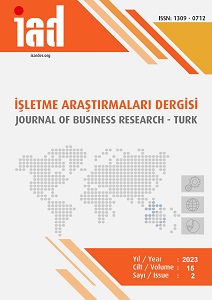İKY Uygulamalarında Dönüşüm ve Dijitalleşme Ölçeğinin Geliştirilmesi
Developing the Scale of Transformation and Digitalization in HRM
Author(s): Rıza Irmak, Harun Demirkaya, Hülya Gündüz ÇekmecelioğluSubject(s): Business Economy / Management, Economic development, Human Resources in Economy, ICT Information and Communications Technologies
Published by: İşletme Araştırmaları Dergisi
Keywords: Human Resources; Management; Digitization; Technological Development; Scale Development;
Summary/Abstract: Purpose- The aim of this study is to develop the scale of transformation and digitalization in Human Resources Management (HRM) applications. The lack of a scale on the digitalization and transformation of human resource management functions in enterprises constitutes the starting point of the study. It has been observed that the studies, articles, papers and theses type of research generally give theoretical information about HRM and that the studies and knowledge on the application are insufficient. In the studies carried out, current developments are mostly handled as electronic human resources management. However, by looking at human resources management holistically, job design, job analysis, HR planning, training and development, job evaluation, staffing, performance management, wage management, improving the quality of working life, career and talent management, labor relations, labor law, risk management, In addition to creating organizational strategies, a need for scale has emerged in relation to digitalization and transformation in personnel affairs and administrative affairs. Scales are measurement tools that determine the necessary constraints and rules for ordering, classifying or finding their degrees. In order for a scale to be reliable and valid, it should be studied and interpreted in accordance with certain standards and criteria. In this direction, a scale has been developed to determine the transformation and digitalization of enterprises in HRM practices. Design/methodology/approach – In the study, a scale was developed to determine the transformation and digitalization of enterprises in HRM practices. In this context, concepts related to transformation and digitalization in HRM practices were determined, and an item pool was created based on this theoretical basis, and a scale was prepared with the selected items. The universe of the study is 387,309 enterprises that are the subject of the research in Turkey according to the data of TUIK (Turkish statistical institution) 2021 "Basic indicators according to the level of technology in the manufacturing industry", and the sample is determined by the convenience sampling method, one of the non-probability sampling techniques, in order for the enterprises to represent the entire population. Explanatory factor analysis was performed with SPSS Statistics 24.00 program and confirmatory factor analysis was performed with SPSS Amos. After the explanatory factor analysis of the 26-item scale created for transformation and digitalization in HRM practices, it was reduced to 21 items and consisted of 7 sub-dimensions. Findings – Explanatory factor analysis was performed on the 26-item scale created for transformation and digitalization scale development in HRM practices. After the items with a difference of 0.1 between the factor loading values in the factor rotation results were removed from the scale, it was reduced to 21 items and consisted of 7 sub-dimensions. According to the EFA results, the KMO value was found to be .858 and explains 75.49% of the total variance. The factor load values of 21 items constituting the scale were higher than .30. DFA analysis was performed for the scale of transformation and digitalization in HRM applications, and as a result of DFA, it was observed that χ2/sd, GFI, AGFI, CFI, NFI, RMSEA, RMR values were within acceptable limits. When we look at the Cronbach alpha values; .92 for transformation and digitalization in HRM practices, .69 for job analysis, job design dimension, .86 for use of flexible working practices, .67 for human resources planning, procurement and selection dimension, .91 for education, development, career, talent and performance management dimension. It was observed that wage and payments management dimension was .80, improving the quality of work life and occupational health and safety practices dimension was .73, administrative, bureaucratic and social affairs dimension was .87. Discussion- After the digital transformation, the management of human resources has become more human-oriented, more diverse, and therefore more will has emerged in the planning of encouraging works. However, there is no comprehensive study on how businesses should shape their working procedures in order to respond and adapt to changes and new practices in all HR functions, mostly in connection with digitalization. The need to investigate the HRM functions affected by this change with measurable data is the target area of this study. This scale development study will fill the gap in the literature and contribute to future studies on this subject
Journal: İşletme Araştırmaları Dergisi
- Issue Year: 15/2023
- Issue No: 2
- Page Range: 1152-1164
- Page Count: 13
- Language: Turkish

